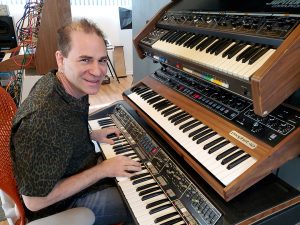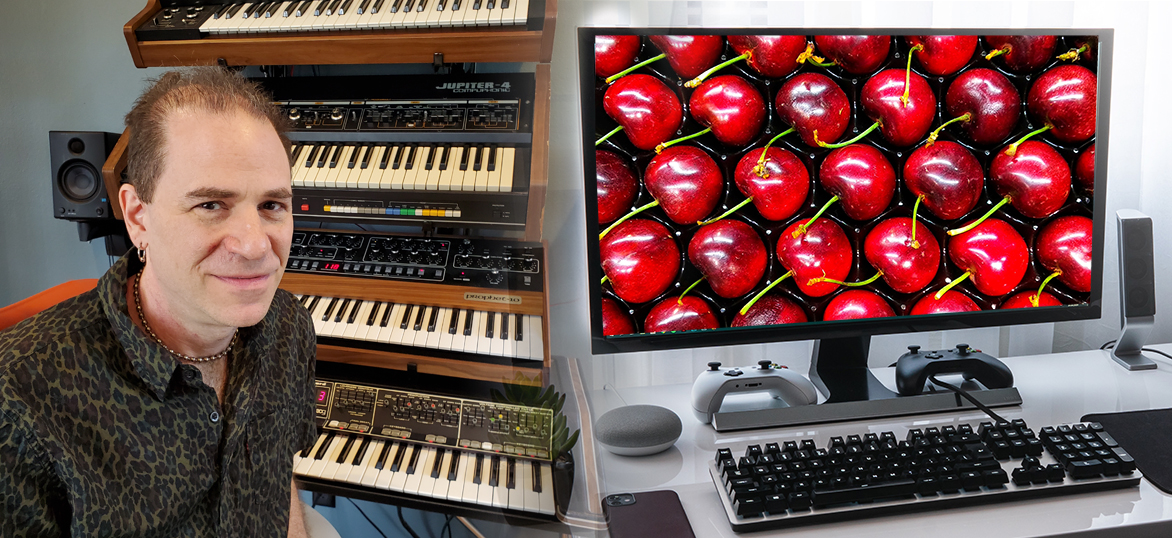By Keith Walsh
Two weeks ago, I downloaded some of the many brilliant software synths at Cherry Audio, and it was like Christmas in October. In a virtual way, I finally realized my decades-long dream of making music on faithful recreations of classic synths like the Memory Moog, the Roland Jupiter 4, the Oberheim OB-8 and others –all in 192k audio. There’s even a spot-on version of the Moog/Radio Shack collaboration, The Realistic Concertmate MG-1. Talk about fun!
After loading several of these into my DAW (Propellerhead Reason), I soon discovered the team at Cherry, located in Las Vegas, had knocked it out of the park, with every single synth I tested. I was blown away by how fat and rich the synths sounded, not to mention the user interfaces which are crafted as faithful duplications of their predecessors, and with great attention to making the user experience as pleasant as possible.
It’s no wonder then, that Cherry Audio’s virtual synths – available in VST3, AAX for Pro Tools and also as standalone devices for live use – are so satisfying. Lead designer Mitchell Sigman of Cherry Audio tells me creating them is both and art and a science. “It’s a little of both,” he said. “Initially we’ll just sort of decide what we want to make and we’re such nerds about it that there’s no formal process for deciding what we’re going to make.”
“Minimum And Maximum”
The designers and engineers at Cherry Audio are the mad scientists of virtual synth creation, and Sigman gave me lots of a fascinating insights into the creation of their products. As he explains, it starts with brainstorming. “It’s really just batting it back and forth and ‘it would be really cool if we did it this or that’ and once we hunker down and start working on something usually it’s one of us, frequently me, but not always…we’ll just make a bunch of audio files where we’ll isolate every single element of it as much as we can, and we’ll just record everything really raw…Just pure oscillator wave forms, white noise, running through the filter, all the envelopes, minimum and maximum, to see what the times are and see what the curves are. So we just analyze it as much as we can.”
Like so many keyboardists, Sigman fell in love with synthesizers when first hearing them on records growing up. It’s that love of synths and electronic music that is a necessary, but not a sufficient, prerequisite for designing soft synths. And it turns out there are various approaches to dialing in the correct sound and character of a given analog instrument, all of which involve a passion for analog synthesis.
As Sigman explained: “Some of it is knowing about electronics, but a lot of it is more practical knowledge. And knowing how to look at a waveform and going, ‘ok, well that’s a square wave, but you can tell from that little angle there that it’s been high pass filtered. So you can deduce. And that’s one of those things that you pick up the more you do it…and obviously (we have) the ability to code and actually get the sound right.”

‘The Little Quirks’
After falling in love with synthesizers as teenager, and as a fan of Berlin’s Pleasure Victim at the age of 13, Sigman found himself playing in Berlin from 2000 to 20007, as well as writing a synth-related column for Keyboard Magazine for six years (check out the compilation, Steal This Sound). Ten years ago, Sigman found himself in Las Vegas, where met Dan Goldstein, founder and chief technical officer of Cherry Audio, and they got to work on a virtual modular synth called Voltage. Since that time, Sigman has had the opportunity to tear apart hardware synths, analyze interfaces and waveforms, in order to create some of the tastiest software synths ever heard. I asked him, when replicating the character of early analog synths, do you sometimes intentionally leave some of the flaws in?
“You kind of always do actually,” he said, “because those flaws are usually what give it the character… a lot of people (say) ‘the sound of the synths is the filter or the sound of the synth is that oscillator’ and they couldn’t be more wrong. The sound of the synth is all those elements put together — the little quirks of each section and the way they’re gain staged. The Juno 106 is a very clean sounding synth that doesn’t have a lot of gain, it doesn’t distort. A MemoryMoog or a Prophet V or an Oberheim is really hot and easy to distort. So that’s the sound.” As an example, Sigman pointed out that the original MemoryMoog distorts slightly when the mixer levels are over three, and factoring this into their MemoryMode is just one example of the lengths Sigman and his colleagues go to, ensuring the accuracy of the sound of their soft synths.
“A Balancing Act”
Using variations on the C+ and JAVA programming languages, Dan Goldstein, James Terris, Mark Barton and others at Cherry Audio dial in the sounds of classic synths flawlessly. And it’s not just synths – Cherry recently released their version of Roland’s Space Echo, The Stardust 201, and it’s an immaculate reproduction that lends that classic tape echo feel to your digital productions. And despite taking a few small liberties with classic analog synthesizer designs – like adding 12 more voices to their Mercury 4 (a Roland Jupiter 4 emulation) or adding a few digital effects to their MemoryMode (their MemoryMoog emulation) – Cherry Audio’s virtual synths are pretty damn close to the originals.
As Sigman explained: “It always a balancing act, because our stuff, if you look at it, there’s not a lot of hidden menus. In fact, the only hidden menus are like preferences that are, ‘set and forget’ kind of things. Yeah, there aren’t pop up things and hidden things, very much. We very much try to keep it hands on — everything in front of you, you see exactly where you’re at and what you’re doing to keep it like using a real instrument. So that’s a big thing for us. And to answer your question, yeah, you want to keep the vibe of the original instrument. The best example we can give is when we started doing the VST, and we did the DCO 106, James and Dan and I were talking and they were like, ‘ah, well, you know, we should add another oscillator,’ and ‘we should add another envelope generator…’ I was like, ‘Whoa! Stop!’ You just made a Jupiter-8.’”
“We really want to maintain the vibe of what we’re doing,” said Sigman, “and it was the same thing doing the Mercury 4, where it’s the Jupiter 4 on the surface is a very simple synth, although it does some interesting things that make it really kind of deeper than that. So you really have to decide. I’m sort of a purist. If it was up to me, I’d make it four voices, no effects except the chorus — I’d make it just like the real thing. But the reality is that you probably don’t want to do that. That because four voices, actually, in reality kind of sucks a lot.’”
Sigman explained that hours of deliberation goes into these decisions about their virtual synths, but it always comes down to the user experience. “A lot of thought goes into that. ‘Do we add this, do we not add this?’ The additional effects, that’s always a tough one too, because they take up panel space, and they’re not technically correct. But the reality is, most people who have come up in the last decade or two, they’re not used to hearing a completely dry synth…most people when they hear an analog synth with nothing on it, they’re ‘well, that doesn’t sound like much.’ So it was kind of a decision of like, ‘well, if we add the effects, it’s going to sound impressive like it would in a mix.’ That’s why we do it.”
Virtual Advantages
Turning to FM synthesis, I asked Sigman how he would improve the experience of using algorithm-based synths, with their notoriously challenging interfaces. Cherry Audio has tackled the problem with the FM Station, a module for their Voltage Modular synth. “The FM Station is a four op (operator) FM module,” he said. “What we did was it’s a very graphic thing, where you’ve got these vertical bars that show how much modulation you’re getting from one oscillator against the other one. So hopefully it makes it really visual and easy to do. It was kind of inspired by the AKAI AX80 that had all those florescent blue vertical bar displays, and I thought ‘it would be really cool to do something like that.’ So hopefully that visual makes it easier to understand. Because it really doesn’t do you much good to see this visual of a waveform, a fast moving waveform.”
Virtual synths have their advantages, over hardware synths, not only because of portability and maintenance issues. At the end of the day it’s all about the user experience and maintaining authenticity. As Sigman pointed out: “The entire synth is a display for us. We can do anything we want in that sense, whereas with the hardware synths you’ve got limited display capabilities.” Still, as Sigman suggests, there are practical and aesthetic limits which dictate designs. “Hardware doesn’t cost anything in virtual instruments,” he said. “We could have 27 oscillators and 400 knobs. It’s easy to get carried away and feature creep, and we try not to do that because you want to maintain the vibe of it.”
Disclaimer: Cherry Audio provided me with review versions of their virtual products in advance of this interview. Thanks to Brent Meyer for the introduction.
Cherry Audio .com
Cherry Audio On YouTube
Cherry Audio On Facebook
Mitchell Sigman .com
finis
